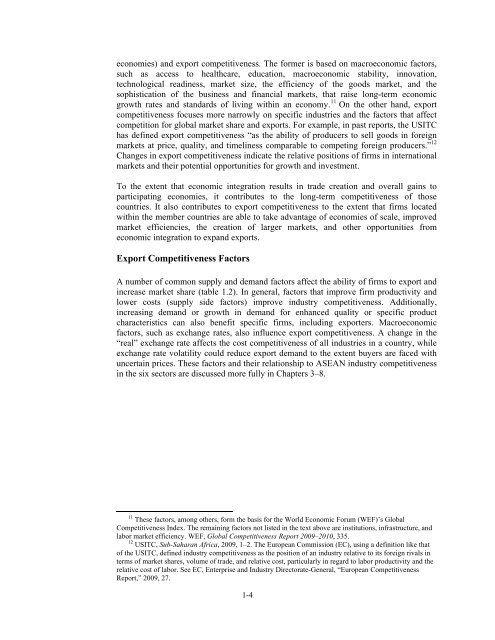ASEAN: Regional Trends in Economic Integration, Export ... - USITC
ASEAN: Regional Trends in Economic Integration, Export ... - USITC
ASEAN: Regional Trends in Economic Integration, Export ... - USITC
You also want an ePaper? Increase the reach of your titles
YUMPU automatically turns print PDFs into web optimized ePapers that Google loves.
economies) and export competitiveness. The former is based on macroeconomic factors,<br />
such as access to healthcare, education, macroeconomic stability, <strong>in</strong>novation,<br />
technological read<strong>in</strong>ess, market size, the efficiency of the goods market, and the<br />
sophistication of the bus<strong>in</strong>ess and f<strong>in</strong>ancial markets, that raise long-term economic<br />
growth rates and standards of liv<strong>in</strong>g with<strong>in</strong> an economy. 11 On the other hand, export<br />
competitiveness focuses more narrowly on specific <strong>in</strong>dustries and the factors that affect<br />
competition for global market share and exports. For example, <strong>in</strong> past reports, the <strong>USITC</strong><br />
has def<strong>in</strong>ed export competitiveness “as the ability of producers to sell goods <strong>in</strong> foreign<br />
markets at price, quality, and timel<strong>in</strong>ess comparable to compet<strong>in</strong>g foreign producers.” 12<br />
Changes <strong>in</strong> export competitiveness <strong>in</strong>dicate the relative positions of firms <strong>in</strong> <strong>in</strong>ternational<br />
markets and their potential opportunities for growth and <strong>in</strong>vestment.<br />
To the extent that economic <strong>in</strong>tegration results <strong>in</strong> trade creation and overall ga<strong>in</strong>s to<br />
participat<strong>in</strong>g economies, it contributes to the long-term competitiveness of those<br />
countries. It also contributes to export competitiveness to the extent that firms located<br />
with<strong>in</strong> the member countries are able to take advantage of economies of scale, improved<br />
market efficiencies, the creation of larger markets, and other opportunities from<br />
economic <strong>in</strong>tegration to expand exports.<br />
<strong>Export</strong> Competitiveness Factors<br />
A number of common supply and demand factors affect the ability of firms to export and<br />
<strong>in</strong>crease market share (table 1.2). In general, factors that improve firm productivity and<br />
lower costs (supply side factors) improve <strong>in</strong>dustry competitiveness. Additionally,<br />
<strong>in</strong>creas<strong>in</strong>g demand or growth <strong>in</strong> demand for enhanced quality or specific product<br />
characteristics can also benefit specific firms, <strong>in</strong>clud<strong>in</strong>g exporters. Macroeconomic<br />
factors, such as exchange rates, also <strong>in</strong>fluence export competitiveness. A change <strong>in</strong> the<br />
“real” exchange rate affects the cost competitiveness of all <strong>in</strong>dustries <strong>in</strong> a country, while<br />
exchange rate volatility could reduce export demand to the extent buyers are faced with<br />
uncerta<strong>in</strong> prices. These factors and their relationship to <strong>ASEAN</strong> <strong>in</strong>dustry competitiveness<br />
<strong>in</strong> the six sectors are discussed more fully <strong>in</strong> Chapters 3–8.<br />
11 These factors, among others, form the basis for the World <strong>Economic</strong> Forum (WEF)’s Global<br />
Competitiveness Index. The rema<strong>in</strong><strong>in</strong>g factors not listed <strong>in</strong> the text above are <strong>in</strong>stitutions, <strong>in</strong>frastructure, and<br />
labor market efficiency. WEF, Global Competitiveness Report 2009–2010, 335.<br />
12 <strong>USITC</strong>, Sub-Saharan Africa, 2009, 1–2. The European Commission (EC), us<strong>in</strong>g a def<strong>in</strong>ition like that<br />
of the <strong>USITC</strong>, def<strong>in</strong>ed <strong>in</strong>dustry competitiveness as the position of an <strong>in</strong>dustry relative to its foreign rivals <strong>in</strong><br />
terms of market shares, volume of trade, and relative cost, particularly <strong>in</strong> regard to labor productivity and the<br />
relative cost of labor. See EC, Enterprise and Industry Directorate-General, “European Competitiveness<br />
Report,” 2009, 27.<br />
1-4

















